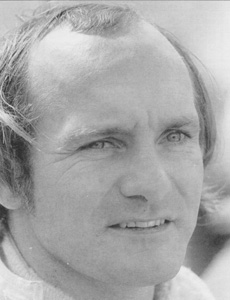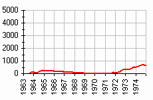Гонщики, H | |
Hailwood, Mike Курсивом отмечены гонщики, |
| Майк ХэйлвудHailwood, MikeHailwood, Stanley Michael Bailey |
 (c) 'Who is Who' by Steve Small, 2000 Родился: 02.04.1940 Грейт-Милтон, Бирмингем Умер: 23.03.1981 Бирмингем Сезонов в Ф1: Лет в Ф1: 12 Гран При: Старты: 49* *не стартовал: 2 Победы: - подряд: Подиумы: - подряд: Поул-позиции: - подряд: Первый ряд: - подряд: Быстрые круги: - подряд: Лучший финиш: Лучший старт: 4 Дубли: Хет-трики: Лидирование старт/финиш: Большие шлемы: Круги: - лидирования: 5 Километры: - лидирования: |
Год | Команда | Шасси |
Despite being the son of a brash millionaire, Mike Hailwood was totally without affectation and truly one of racing's 'nice guys'. He lived life to the full, but was nevertheless a dedicated sportsman who was undoubtedly one of motor cycle racing's greatest-ever exponents -many consider him the greatest of them all - and a fine all-round racing driver who missed out on ultimate success but still left a not inconsiderable mark on the four-wheeled sport.
By the age of 18 he was already a British motor cycle champion in four classes, winning his first World Championship in 1961. During the next six seasons Mike took a further eight World Championships in the 500 cc, 350 cc and 250 cc classes. His first taste of four-wheeled competition came in 1963, and with a couple of Junior races satisfactorily completed he joined the Reg Parnell team briefly in preparation for a full season the following year. He scored a World Championship point at Monaco in 1964 but felt uncomfortable in the Formula 1 environment, perhaps frustrated at being an also-ran in one category and the top dog in the other. He did a few more races for Parnell in 1965 before concentrating almost exclusively on bikes once more, though he did enjoy some winter sunshine racing sports cars, winning the 1966 Dickie Dale 3 Hours with David Hobbs in Bernard White's GT40.
With Honda having pulled out of Grand Prix motor cycle racing at the end of 1967, the sport was heading for a period of essentially privateer participation, so Mike turned to cars once again from the beginning of 1969. The newly inaugurated F5000 series provided an ideal base to rebuild his career, and in tandem he began a successful sports car programme, mainly for John Wyer, finishing third at Le Mans in 1969. In 1971 he joined forces with John Surtees to race his F5000 car, and benefited greatly from his guidance, taking second place in the series behind Frank Gardner. Late in the year, Surtees put Mike into his Formula 1 team for the Italian GP with startling results. In a great drive, Hailwood jousted for the lead in the four-car bunch which slipstreamed around the Monza circuit before finishing fourth.
Full of confidence, he lined up a massive programme with Surtees for 1972, undertaking the F2 Brazilian Torneio and F5000 Tasman series before the season proper had even started. A second place in the Race of Champions boded well for Formula 1, but Mike's luck was definitely out. In South Africa he put in an astounding drive to pressure Stewart before his suspension broke and at Monza he knew he had the opposition covered before the airbox blew off his Surtees. No one deserved a Grand Prix win more that year, but it was not to be. There was, however, the compensation of taking the European Formula 2 championship for Surtees with some excellent performances.
Unfortunately the progress made was not built upon in 1973, when unreliability beset the team to the extent that Mike failed to finish a single race in the points. In fact his season was best remembered for a typical act of bravery when he rescued Clay Regazzoni from his blazing car in South Africa to earn the George Medal. His only success came in endurance racing, when he shared the John Wyer Mirage with Derek Bell to win the Spa 1000 Km.
Frustrated at his lack of success at Surtees, Hailwood switched to McLaren in 1974, running a third works car in Yardley livery. Suddenly he was back in the frame, always running competitively until an accident at the German Grand Prix left him with such a badly broken leg that it was to spell the end of his Grand Prix career.
He announced his retirement in 1975, but after a couple of years kicking his heels 'Mike the Bike' was back. In a sensational return to the Isle of Man TT races in 1978, he won the Formula 1 event on a Ducati and in 1979 he was back again to smash the lap record and take the Senior TT on his Suzuki. There were no more comebacks, however, for in 1981 Mike lost his life in a tragic road accident when his car ran into a lorry executing an illegal U-turn across a dual carriageway after he had nipped out for a fish and chip family supper. The entire world of racing, on both two wheels and four, were united in their grief at the loss of one of motor sport's most popular and genuine sons.
(c) 'Who is Who' by Steve Small, 2000
| © WildSoft, 1995-2020 |


